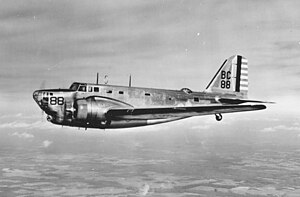Douglas B-18 Bolo
| B-18 Bolo | |
|---|---|
 |
|
| B-18A | |
| Role | Medium bomber |
| Manufacturer | Douglas Aircraft Company |
| First flight | April 1935 |
| Introduction | 1936 |
| Retired | 1946 Brazilian Air Force |
| Primary users |
United States Army Air Corps United States Army Air Forces Royal Canadian Air Force Brazilian Air Force |
| Produced | 1936– |
| Number built | 350 |
| Unit cost |
US$58,500 (1935)
|
| Developed from | Douglas DC-2 |
| Developed into | Douglas B-23 Dragon |
The Douglas B-18 Bolo is an American medium bomber which served with the United States Army Air Corps and the Royal Canadian Air Force (as the Digby) during the late 1930s and early 1940s. The Bolo was built by the Douglas Aircraft Company, based on its DC-2, and was developed to replace the Martin B-10.
By 1940, it was considered to be underpowered, to have inadequate defensive armament and to carry too small a bomb load. Many were destroyed during the attacks on Pearl Harbor and the Philippines in December 1941.
In 1942, the B-18 survivors were relegated to antisubmarine, transport duty, and training. A B-18 was one of the first American aircraft to sink a German U-boat, U-654 on 22 August 1942 in the Caribbean.
In 1934, the United States Army Air Corps put out a request for a bomber with double the bomb load and range of the Martin B-10, which was just entering service as the Army's standard bomber. In the evaluation at Wright Field the following year, Douglas showed its DB-1. It competed with the Boeing Model 299 (later the Boeing B-17 Flying Fortress) and Martin Model 146.
While the Boeing design was clearly superior, the crash of the B-17 prototype (caused by taking off with the controls still locked) removed it from consideration. During the depths of the Great Depression, the lower price of the DB-1 ($58,500 vs. $99,620 for the Model 299) also counted in its favor. The Douglas design was ordered into immediate production in January 1936 as the B-18.
The DB-1 design was essentially that of the DC-2, with several modifications. The wingspan was 4.5 ft (1.4 m) greater. The fuselage was deeper, to better accommodate bombs and the six-member crew; the wings were fixed in the middle of the cross-section rather than to the bottom due to the deeper fuselage. Added armament included nose, dorsal, and ventral gun turrets.
...
Wikipedia
